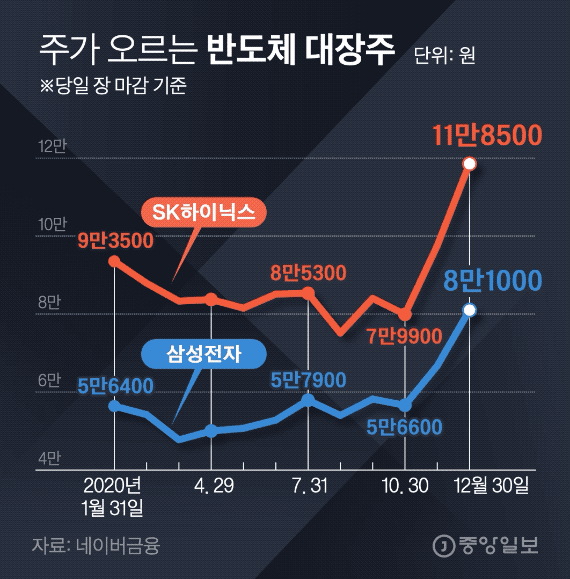Expectations for a’supercycle’ (long-term boom) in the Korean semiconductor market are growing. Most of the domestic industries are staggering in the aftermath of the novel coronavirus infection (Corona 19), but the semiconductor industry is expected to continue to grow this year following last year.
Expectations are leading to a rise in share prices of Samsung Electronics and SK Hynix, the two biggest mountains in the domestic semiconductor industry. Samsung Electronics’ stock price, which was around 50,000 won at the beginning of last year, ended at a record high of 81,000 won at the end of the year, with individual investors, symbolized by the so-called’Donghak ant,’ in the second half. SK Hynix’s share price also jumped nearly 30% throughout the year.

Semiconductor’s leader in rising stock prices. Graphic = Reporter Kim Kyung-jin [email protected]
Despite the Corona 19 pandemic (a global pandemic), the semiconductor market enjoyed a boom last year. In particular, memory semiconductors, the cornerstone of’semiconductor Korea’, led the growth. According to Omdia, a global market research firm, the total DRAM market sales amounted to $65.643 million last year, up 5% compared to 2019. NAND flash also increased by 23% from 46 billion dollars (about 50 trillion won) to 56.888 billion dollars (about 61 trillion won) during the same period. The atmosphere is better this year. It was analyzed that DRAM prices increased by 23% from last year to reach $81.39 billion (approximately 88.39 trillion won), and NAND flash sales increased by 14% to $64.9 billion (approximately 70 trillion won). The two companies account for 70% and 50% of the DRAM and NAND flash markets, respectively.
In the memory semiconductor market, Corona 19 has benefited again. Demand for products requiring memory semiconductors such as laptops, smartphones, and servers has increased due to the spread of telecommuting and the establishment of non-face-to-face infrastructure. In addition, demand is steadily increasing due to the expansion of the development of 5G (5G) mobile communications, artificial intelligence (AI), and autonomous vehicles. China’s pursuit has also slowed down. In November of last year, Tsinghua Unigroup, who is at the forefront of China’s semiconductor industry, declared default. As China’s’localization of semiconductors’, which imports over $300 billion annually, is delayed, Korea is more advantageous.
This is why the industry is looking forward to a supercycle this year. The domestic semiconductor market grew significantly from 2009 to 2011 as smartphones became popular. Following the rapid increase in the amount of data to be dealt with due to advances in smartphone technology, the data center has grown booming since 2016.
According to the Ministry of Trade, Industry and Energy, in 2018, Korea’s semiconductor exports amounted to 126.7 billion dollars (about 13.7 trillion won), a record high. Last year, as of November, it is expected to exceed 100 billion dollars, the second time in history, with 87.9 billion dollars (about 97.69 trillion won). This is more than 20% of the total domestic exports.
Expectations for the earnings of Samsung Electronics and SK Hynix are also high. According to F&Guide, a financial information company, Samsung Electronics’ operating profit forecast for last year was 37 trillion won, up 32% from 2019. This year, it is forecast at 45 trillion 72.3 billion won. SK Hynix’s operating profit last year is estimated to be 4.92 trillion won, up 81% from the previous year. This year, it is expected to reach 8,533.8 billion won.

The growing semiconductor market. Graphic = Reporter Kim Kyung-jin [email protected]
Accordingly, expectations for an additional share price rise are also high. Securities companies predicted the target price of Samsung Electronics and SK Hynix at around 90,000 won and 150,000 won, respectively. Among individual investors, the so-called ‘100,000 electrons’ theory that the share price of Samsung Electronics will exceed 100,000 won is emerging.
Some views are mixed with concerns. Investment in semiconductor facilities, which had been slow in 2019, increased significantly last year. This means that supply can increase as much as demand this year. Choi Jae-sung, a professor at the Department of Semiconductor Equipment Engineering at Far East University, said, “The scale of facility investment last year was at the level of 2017-2018, which was the cause of the decline in semiconductor prices in 2019.”
There is also a prediction that only the bulk (sales) will grow and the stall (operating profit) may be insolvent. Recently, securities firms adjusted Samsung Electronics’ fourth quarter operating profit forecast to the beginning of the 9 trillion won range, which is 300 to 500 billion won lower than before. The reason is the increase in the value of the won and European lockdown (blockade) caused by Corona 19.
“The boom in 2018 was due to the fact that Japan gained reflected profits through the dark period of facility investment for many years as memory companies collapsed into’chicken games’ caused by intensifying competition,” said Lee Joo-wan, a research fellow at POSCO Research Institute. It is difficult to enjoy this boom of more than 50%.”
Reporter Choi Hyun-joo [email protected]
